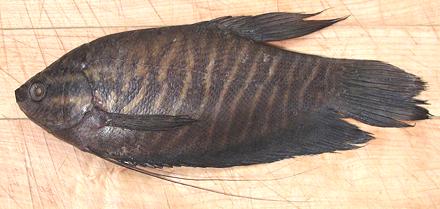 [Cá Sac Ran (Viet); Pla Salid (Thai); Pla Salit (Filipino);
Trichogaster pectoralis]
[Cá Sac Ran (Viet); Pla Salid (Thai); Pla Salit (Filipino);
Trichogaster pectoralis]
Found in the rivers of Southeast Asia this fish can grow to nearly 10 inches and 1 pound in weight, but the photo specimen was 7-1/4 inches and weighted 3-1/4 ounces. Note that the pelvic fins have become long threads extending from below the pectoral fins almost to the tail. Able to breath air, this fish can stay alive for days out of the water if kept moist. Considered a good eating fish it is both fished and farmed, and is not considered threatened.
More on Gouramies.
Snakeskin Gourami is popular in Southeast Asia, grilled or in soup, and is also dried for use in soup in inland areas. The flesh is firm, of light color and medium flavor, with a pleasant taste. Unlike many small fish with full length fins, this one is easy to disassemble on the plate, either pan fried, grilled or steamed. The fins and bones hold together well and are manageable.
It is also used to make fermented fish sauces called Pa Daek in Laos and Nam Pla Ra in Issan, Thailand. For details see our Tuk Prahok Sauce page.
Buying: Snakeskin Gourami can be found in the freezer cases of markets serving a Southeast Asian community. The photo specimens came from Vietnam, purchased from a large Asian market in Los Angeles for about 2011 U.S. $3.33 per pound.
Scales: This fish is completely covered with a dense coat of tiny scales. They have good adhesion and require some vigor to scrape off. Some of them will have to be shaved off with the sharp edge of your prep knife.
Cleaning: The only practical way to clean this fish is to cut off the head. The body cavity is very short, and the innards are mushy and poorly defined, but scrape out fairly easily.
Filleting: This fish is fairly easy to fillet, though the fillets are small. The bone structure is complete and easy to follow with the filleting knife.
Yield: A 3-1/4 ounce fish yielded 1-1/4 ounces of skin-on fillet (38%) and 1 ounce skin-off (31%).
Skin: The skin is tough and has significant shrink. It will curl a fillet fairly badly, though it can be flattened as it finishes cooking. When cooking a whole, head-off fish, the skin shrink is not a problem because the fish is so small. The skin has a stronger taste than the flesh but not unpleasantly so and does not have an "off" flavor. It is easily removed from fillets using the standard long knife and cutting board Method.
Cooking: The most common way to cook this fish will be "head off", since the head needs to be removed to get at the innards. It can be pan fried, grilled or steamed in this form. The flesh stays firm enough for various forms of wet cooking.
Stock: Snakeskin heads, bones and fins, simmered gently for 1/2 hour, produce a stock of a light tan color with a taste I do not like.
sf_gourssz* 061120 rev 110328 - www.clovegarden.com